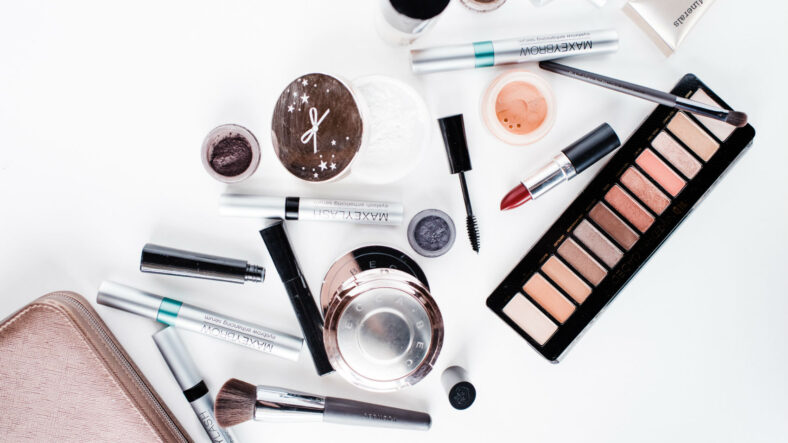
In response to the COVID-19 outbreak, cleanliness is of utmost importance. We’re washing our hands and sanitizing our surfaces more than ever, but what about the beauty products we regularly reach for? According to experts, it’s still unclear exactly how long the coronavirus remains active outside of the body. Current research shows the virus surviving on some hard surfaces, including plastic and steel, for up to 72 hours while it remains active for as few as two hours on others; its activity has not been studied specifically on personal care products. Regardless, the CDC recommends regularly cleaning and disinfecting “high-touch surfaces,” and considering women use on average no less than 16 beauty products per day, it’s probably a good idea to thoroughly clean those you come into contact with most.
The truth is, this is something you should be doing routinely, regardless of a global pandemic. “Beauty products can be carriers of pathogens that include bacteria, viruses, yeasts, and fungi,” explains Francesca Fusco, MD, a dermatologist in New York City. “Improper beauty product hygiene could lead to irritation, rashes, and infections.” The bottom line: We do not know for sure if the coronavirus can live on your products, but we do know that a host of other pathogens can. So, to find out exactly how to clean commonly used beauty products without compromising quality or efficacy, we reached out to the experts. Here, they share their tips and tricks for cleaning and disinfecting makeup brushes, facial tools, hair brushes, and more.
Skincare
The skincare tools that regularly come into contact with your face should be cleaned on a daily basis, says Dr. Fusco. First up: cleansing brushes. “The bristles can harbor makeup, dirt, dead skin cells, and germs, all of which can be transferred back onto your skin,” she explains. Rinse your brush head with warm, soapy water after every use, working your fingers through the bristles, then leave it out to aerate and dry thoroughly (wet surfaces accumulate more bacteria). Every couple of weeks, soak the bristles in rubbing alcohol for a deeper clean, and replace them every three months.
Metal tools or rollers made from stones like jade or rose quartz can be cleaned with warm water and gentle soap. “These tools are easy enough and don’t have many nooks and crannies for pathogens to hide,” says Dr. Fusco. But they can collect residual oil and bacteria, which is why it’s best to gently hand-wash these tools after each use. Just make sure to follow any specific cleaning instructions from the manufacturer and allow these tools time to completely dry before storing to prevent rust.
Finally, don’t forget to clean the packaging of any products you are using. Dr. Fusco suggests wiping down bottles and jars with a Clorox or Lysol wipe. “If you are the only person using the products and you’re applying them with clean hands, then doing so once a week will be sufficient,” she says. Any products that are shared in your household, like body wash or lotion, should be wiped down more frequently.

Makeup
Washing your makeup brushes should be an essential step in your beauty routine. Not only does the buildup of product and oil negatively affect application, but it can also cause breakouts and irritation. “Deep cleaning your makeup brushes once a week ensures that any type of buildup or bacteria is removed,” says Lori Taylor-Davis, Global Pro Lead Artist for Smashbox Cosmetics. Most brands now use synthetic bristles, which are more durable and hold up against soap and water, she adds.
To thoroughly clean your makeup brushes, follow these steps: Squeeze some mild soap (Taylor-Davis likes using a dish-washing liquid like Dawn) into a small bowl and fill with warm water. Swirl the brush bristles in the water, massaging them with your fingers to loosen the buildup, then rinse with clean water; lay flat to dry. In between cleanings, Taylor-Davis suggests using a professional brush cleaner like Parian Spirit Professional Makeup Brush Cleaner ($16; amazon.com) to prevent buildup.
As for the other products in your makeup bag, including pressed powders and cream formulas, Taylor-Davis recommends using a sanitizing spray between uses. One she keeps in her kit: The Pro Hygiene Collection Antibacterial Makeup Sanitizing Spray ($20; feelunique.com), which kills and stops the regrowth of bacteria. In a pinch, you can also mix nine parts rubbing alcohol with one part water. Just be sure to spritz products from a distance — about 10 inches — as too much alcohol can dry out and alter formulas, she cautions.
Also, don’t forget to wipe down or wash the makeup bag itself.
Hair
When it comes to your hair care and styling products, you can simply wipe down packaging and handles with a disinfecting wipe. But there is one tool you should spend a little more time on: your hairbrush. “I would suggest cleaning your hair brushes weekly,” says Steven Picciano, owner of Glass Beauty Bar and Goldwell National Artist. “This can increase depending on how often you are styling your hair, which can lead to more product buildup happening on the brush.” A clean brush is important because you don’t want oil, dead skin, and product residue being applied back onto your scalp or hair.
Picciano’s technique: Start by using a fine-tooth comb to remove all of the hair buildup from the brush. Then, mix warm water with gentle shampoo, and let the brush padding soak in the mixture for up to five minutes. Once soaked, scrub the padding with an old toothbrush to remove any product buildup. As an extra precaution, he suggests finishing with some disinfecting spray. “A little Lysol can go a long way,” he says. Allow the brush to dry completely before using.
Note: We do not claim these techniques will kill or stop the spread of coronavirus. Please visit the CDC website for more information on disinfecting techniques and approved products.
